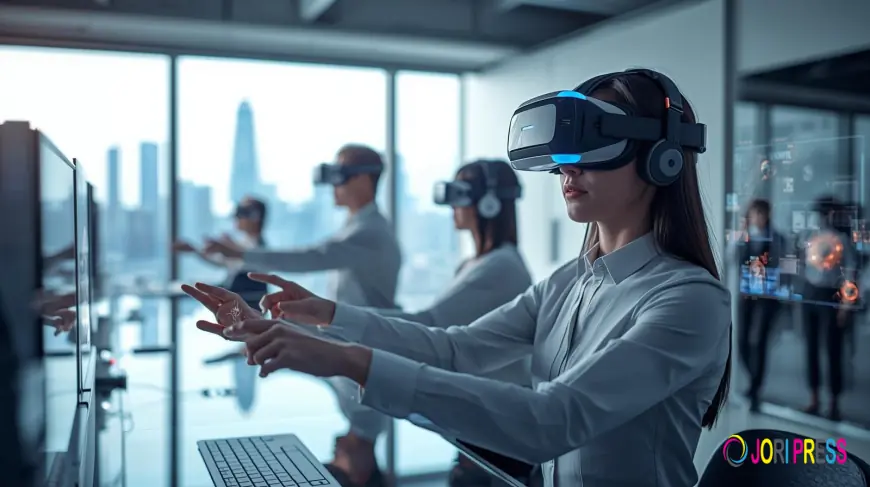Japan Virtual Reality Market 2025 | Size, Share, Trends, and Players to 2033
Japan Virtual Reality Market

Japan Virtual Reality Market Size and Growth Overview (2025-2033)
Market Size in 2024: USD 2.2 Billion
Market Forecast in 2033: USD 8.7 Billion
Market Growth Rate 2025-2033: 16.4%
According to IMARC Group's latest research publication, "Japan Virtual Reality Market: Industry Trends, Share, Size, Growth, Opportunity and Forecast 2025-2033", the Japan virtual reality market size reached USD 2.2 Billion in 2024. Looking forward, IMARC Group expects the market to reach USD 8.7 Billion by 2033, exhibiting a growth rate (CAGR) of 16.4% during 2025-2033.
How AI is Reshaping the Future of the Japan Virtual Reality Market
Japan expects AI to improve its virtual reality (VR) environment. Algorithms based on AI systems can be used in Japanese VR applications to implement realistic environments, smart scene rendering, advanced object recognition, and content creation based on personalization and real-time responses to user input in the virtual environment. In VR, ML is used to realistically animate avatar motion and behavior, enable natural language processing for voice interfaces, and enable predictive analytics that anticipate user actions in virtual spaces. In games, it enables NPCs to display lifelike behavior, and in enterprise applications, it powers clever agents that guide users through virtual world training scenarios in ways never before possible.
This application of AI to VR is also helping to solve the problems of growing demand for VR content and the expense of optimizing the VR experience, as AI-driven tools in Japan are helping local developers create automatically-generated virtual environments. Neural networks also apply to videos in uses like scaling images up, interpolating frame rate, or reducing motion sickness through predicting where a user is likely to move. AI analytics helps developers and content creators learn about users. AI analytics helps developers and content creators provide better experiences. The overlap of artificial intelligence and virtual reality fits well in the Japanese target market, with software being expected to feature cutting-edge technology, precision, and extreme attention to detail.
AI is also being used to make VR a mainstay of the digital transformation in Japan across various sectors. In healthcare, for example, AI-powered VR improves surgical simulations, creates personalized rehabilitation plans, and adapts the plans to patient progress. Educational institutions use AI-driven VR solutions to respond to performance measurements and offer targeted education pathways. In corporate training, smart VR training systems are used to create highly customized scenarios that change according to the learner's skill sets and knowledge. The fusion of AI and VR opens up unique avenues of innovation in more accessible, practical, and valuable engaging experiences across many sectors in Japan's economy, expanding the market and moving beyond the territory of customary entertainment-related applications.
Japan Virtual Reality Market Trends & Drivers
The Japanese virtual reality market is one of the fastest-growing markets in the world. Japan has a long history of technological innovation and is home to a culture of consumer electronics. Japanese consumers have a history of accepting cutting-edge technology, and virtual reality is ultimately the next step. Consumer interest in VR has grown steadily alongside the growing gaming and entertainment market. Because there is already a large video game culture in Japan, location-based VR arcades can take advantage of existing consumer interest to provide high-quality experiences without requiring customers to pay for the expensive equipment on their own. These establishments serve the general public and hard-core fans alike; they have helped to legitimize and popularize the market and have generated substantial revenues.
Another major factor increasing the growth of the healthcare VR solutions market is the increasing adoption of VR solutions in Japan for surgical training in hospitals. Medical professionals solve problems with VR to practice complex surgical procedures inside a highly accurate virtual environment without risk of affecting real patients. VR's therapeutic uses are gaining popularity. VR-based therapies treat pain management, physical rehabilitation, and mental health issues such as anxiety disorders or post-traumatic stress disorder. Government support for technology and innovation in several countries is also conducive to the development of VR. VR has become a tool used by educators, allowing students to explore historical events and sites, phenomena, and environments, or participate in other interactive learning experiences. VR is also being adopted by businesses as a training tool (mostly in industry and manufacturing), allowing employees to practice procedures and skills on virtual equipment without endangering human lives. With the presence of strong technical infrastructure, growing acceptance by consumers,a wide application area, and support from institutions, the Japanese virtual reality market is expected to grow rapidly.
Japan Virtual Reality Industry Segmentation:
The report has segmented the market into the following categories:
Device Type Insights:
- Head-Mounted Display
- Gesture-Tracking Device
- Projectors and Display Wall
Technology Insights:
- Semi and Fully Immersive
- Non-Immersive
Component Insights:
- Hardware
- Software
Application Insights:
- Aerospace and Defense
- Consumer
- Commercial
- Enterprise
- Healthcare
- Others
Regional Insights:
- Kanto Region
- Kinki Region
- Central/ Chubu Region
- Kyushu-Okinawa Region
- Tohoku Region
- Chugoku Region
- Hokkaido Region
- Shikoku Region
Competitive Landscape:
The market research report offers an in-depth analysis of the competitive landscape, covering market structure, key player positioning, top winning strategies, a competitive dashboard, and a company evaluation quadrant. Additionally, detailed profiles of all major companies are included.
Recent News and Developments in Japan Virtual Reality Market
- June 2024: Apple launched its revolutionary Vision Pro spatial computing headset in Japan, marking a significant milestone as the device became available outside the United States for the first time. The launch expanded access to advanced mixed reality technology across Japanese markets, with Apple Stores offering personalized demonstration experiences to showcase the headset's capabilities in blending digital content with physical environments.
- January 2024: Sony Corporation introduced an innovative XR head-mounted display featuring advanced video see-through capabilities and optimized controllers for intuitive interaction with three-dimensional objects. The device represents Sony's continued commitment to pushing the boundaries of virtual reality technology, offering enhanced visual quality and precision control for both entertainment and professional applications.
- September 2024: Sony Interactive Entertainment launched the PlayStation 5 Pro in Japan, incorporating advanced graphics processing capabilities, sophisticated ray tracing technology, and AI-driven upscaling features. These enhancements significantly improve virtual reality gaming experiences, delivering higher frame rates, superior visual fidelity, and smoother performance for immersive gameplay.
- November 2024: SEGA Amusements unveiled an exciting portfolio of innovative arcade games featuring cutting-edge virtual reality technology and immersive gameplay mechanics. The new releases demonstrate the ongoing evolution of location-based VR entertainment, offering social interaction and engaging experiences that attract diverse audiences to family entertainment centers across Japan.
Future Outlook
The Japan virtual reality market is set for strong growth, driven by technological advances, expanding applications in healthcare, education, manufacturing, and entertainment, and supportive initiatives. Innovations in hardware, 5G, AI, and content ecosystems will further boost market expansion.
Key highlights of the Report:
- Market Performance (2019-2024)
- Market Outlook (2025-2033)
- COVID-19 Impact on the Market
- Porter's Five Forces Analysis
- Strategic Recommendations
- Historical, Current and Future Market Trends
- Market Drivers and Success Factors
- SWOT Analysis
- Structure of the Market
- Value Chain Analysis
- Comprehensive Mapping of the Competitive Landscape
Note: If you require specific details, data, or insights that are not currently included in the scope of this report, we are happy to accommodate your request. As part of our customization service, we will gather and provide the additional information you need, tailored to your specific requirements. Please let us know your exact needs, and we will ensure the report is updated accordingly to meet your expectations.
About Us:
IMARC Group is a global management consulting firm that helps the world's most ambitious changemakers to create a lasting impact. The company provides a comprehensive suite of market entry and expansion services. IMARC offerings include thorough market assessment, feasibility studies, company incorporation assistance, factory setup support, regulatory approvals and licensing navigation, branding, marketing and sales strategies, competitive landscape and benchmarking analyses, pricing and cost research, and procurement research.
Contact Us:
Street: 563-13 Kamien
Area: Iwata
Country: Tokyo, Japan
Postal Code: 4380111
Email: [email protected]
What's Your Reaction?
 Like
0
Like
0
 Dislike
0
Dislike
0
 Love
0
Love
0
 Funny
0
Funny
0
 Angry
0
Angry
0
 Sad
0
Sad
0
 Wow
0
Wow
0















































